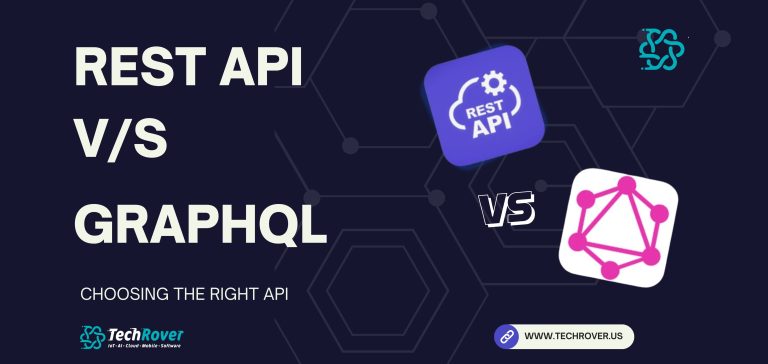REST API vs. GraphQL: Choosing the Right Tool for Your Project

In today’s fast-paced digital era, APIs form the backbone of modern application development, enabling seamless communication between client applications and servers. Two of the most popular API architectures are REST (Representational State Transfer) and GraphQL.
At Techrover™ Solutions, where innovation meets tailored technology, we often help our clients navigate this crucial decision. Here, we’ll break down the key differences, advantages, and use cases of REST and GraphQL to help you make an informed choice for your next project.
REST API: The Tried-and-True Veteran
REST has been the standard for building APIs since its introduction in 2000. Known for its simplicity and wide adoption, REST is based on HTTP principles and uses URLs to access resources.
Key Features
- Resource-Oriented: Each endpoint represents a resource (e.g., /users, /products), and CRUD operations are mapped to HTTP methods (GET, POST, PUT, DELETE).
- Statelessness: Each request from a client to a server must contain all the information needed to process the request.
- Standardized Structure: REST APIs rely on conventional status codes, headers, and request/response formats, often in JSON.
Advantages
- Wide Adoption: REST is supported by virtually all programming languages and tools.
- Caching: HTTP-based caching improves performance by storing responses for repeated requests.
- Flexibility: REST APIs can handle a variety of data formats like JSON, XML, and more.
Limitations
- Over-fetching and Under-fetching: Clients may receive too much or too little data, leading to inefficiencies.
- Multiple Requests: Accessing related data often requires multiple API calls (e.g., fetching a user’s details and their posts).
GraphQL: The Modern Contender
Developed by Facebook in 2015, GraphQL offers a flexible and efficient alternative to REST. Unlike REST, GraphQL is a query language for APIs that allows clients to request exactly the data they need.
Key Features
- Schema-Based: GraphQL APIs expose a strongly-typed schema that defines the available data and relationships.
- Single Endpoint: Instead of multiple endpoints, GraphQL uses one endpoint for all queries and mutations.
- Declarative Queries: Clients define the structure of the required response in the query.
Advantages
- Efficiency: Clients receive only the requested data, reducing bandwidth usage.
- Flexibility: One API call can fetch related data from multiple resources.
- Strong Typing: The schema ensures better validation and tooling for API development.
Limitations
- Complex Setup: Building and maintaining a GraphQL server requires additional expertise.
- Overhead: GraphQL servers can be resource-intensive for simple use cases.
- Caching Challenges: The lack of HTTP caching makes optimization more complex.
What are the differences between GraphQL and REST?
GraphQL and REST have several differences in their design patterns and approach to data modeling. These differences include:
Enforced schema
- GraphQL enforces the use of a schema—regardless of whether developers are taking a schema-first or code-first approach. With the code-first approach, the schema is generated from the resolvers.
- REST does not enforce the use of a schema. Developers can take a schema-first approach with REST by using API specifications like OpenAPI and AsyncAPI, or they can auto-generate schemas from code, but it is not an integral part of the REST architecture.
Popularity
- GraphQL was released by Facebook in 2015. It has been rapidly growing since then and has gained a lot of popularity over the last few years. According to Postman’s State of the API report, 29% of developers make use of GraphQL.
- REST has been widely used for several decades and is a well-established standard for building APIs—especially public ones. According to the State of the APIs report, 90% of developers use REST APIs.
REST vs. GraphQL: When to Use What?
Choose REST If:
- Your application needs a simple, standardized API.
- Caching is critical to your performance requirements.
- You’re working with legacy systems or teams familiar with REST.
Choose GraphQL If:
- Your application demands flexibility in data fetching (e.g., mobile apps with varying data needs).
- Minimizing over-fetching and under-fetching is essential.
- You’re building a modern, highly interactive user interface with complex data requirements.
Techrover™ Take on API Selection
At Techrover™ Solutions, we understand that both REST and GraphQL are powerful tools, each with its own strengths. The key to choosing the right one lies in truly understanding your project’s unique needs—whether it’s scalability, performance, flexibility, or developer expertise. With the right API strategy, your project can unlock its full potential.
We’ve partnered with startups, enterprises, and everything in between, guiding them through the process of selecting and implementing the ideal API for their goals. Whether it’s optimizing an existing REST API for maximum efficiency or transitioning to GraphQL for more dynamic, responsive data fetching, our team ensures a seamless, hassle-free integration that drives real, measurable growth.
Let Techrover™ be your trusted partner in navigating the API landscape. With our deep industry knowledge and hands-on experience, we’ll help you make the right choice that aligns with your project vision, ensuring scalability, performance, and future-proofing for your business. Ready to make your API work harder for you? Let’s build the perfect solution together!




Pingback: Redis: The Ultimate Game-Changing In-Memory Powerhouse For High-Performance Apps 7